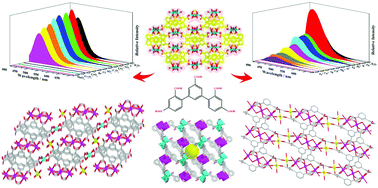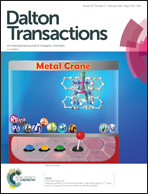Four new metal–organic frameworks based on diverse secondary building units: sensing and magnetic properties†
Abstract
Four new metal–organic frameworks (MOFs), {[Zn3(L)(OH)(H2O)5]·NMP·2H2O}n (1), {[H2N(Me)2][Zn2(L)(H2O)]·DMF·H2O}n (2), {[Co5(L)2(H2O)11]·2H2O}n (3) and {[Mn5(L)2(H2O)12]·6H2O}n (4), were assembled employing a symmetrical V-shaped rigid multicarboxylic acid ligand H5L (H5L = 2,4-di(3′,5′-dicarboxylphenyl)benzoic acid) with different metal ions, resulting in versatile frameworks as well as various types of coordination modes of H5L. 1 forms a three-dimensional (3D) 4-connected sra net based on trinuclear [Zn3(μ3-OH)(μ2-COO)(μ1-COO)4] clusters, while 2 displays a 3D (4,6)-connected net based on two types of binuclear [Zn2(μ2-COO)2(μ1-COO)4] and [Zn2(μ2-COO)4] clusters. 3 and 4 contain similar [M3(μ2-COO)4(μ1-COO)2] (3, M = Co; 4, M = Mn) clusters but result in different 4-connected 3D and 2D frameworks, respectively. 1 and 2 show solid-state luminescence properties at ambient temperature. Meanwhile, 1 shows high selectivity and sensitivity for not only Fe3+ cations but also for CrO42−, Cr2O72− and MnO4− anions via a luminescence quenching effect with a low detection limit, which thus means that it could be a potential crystalline material for detecting these anions. The mechanisms of the quenching effect and sensing properties of 1 are discussed in detail. In addition, 3 and 4 have the presence of antiferromagnetic interactions between the metal ions.



 Please wait while we load your content...
Please wait while we load your content...